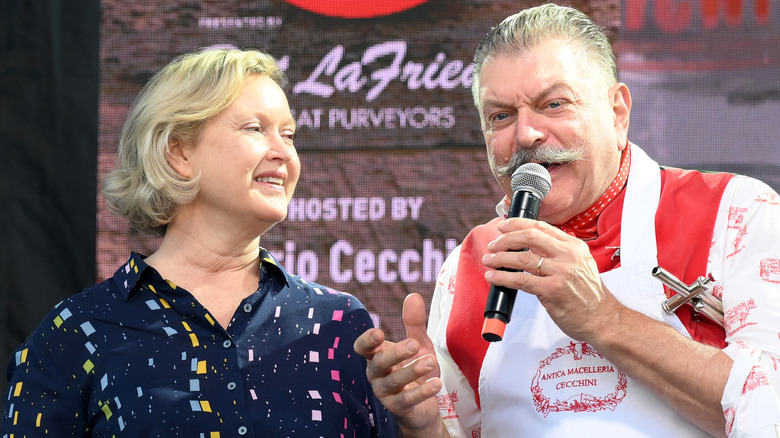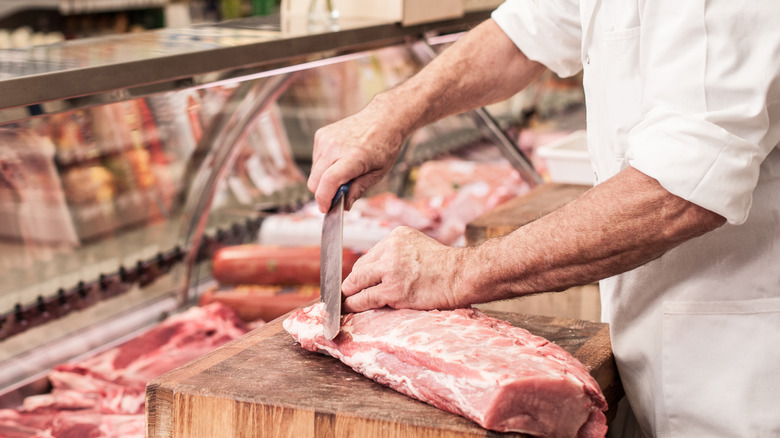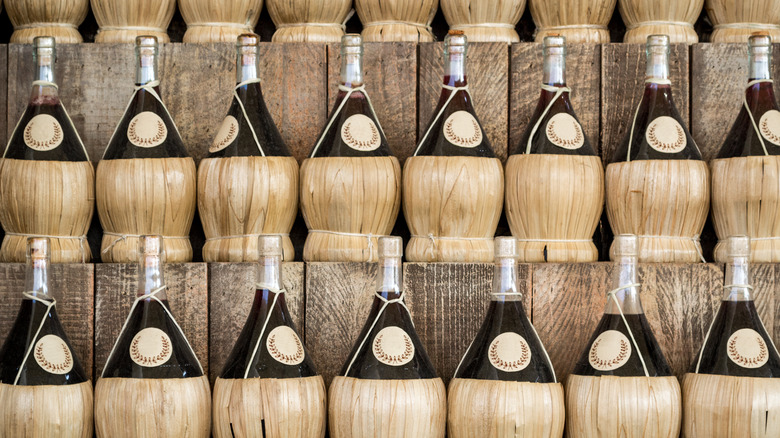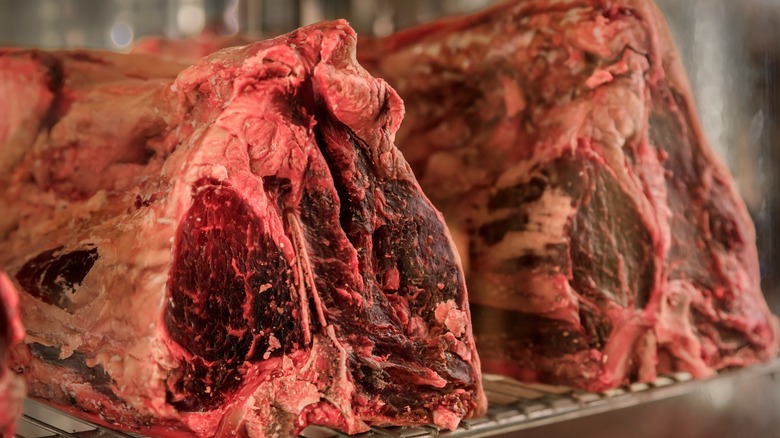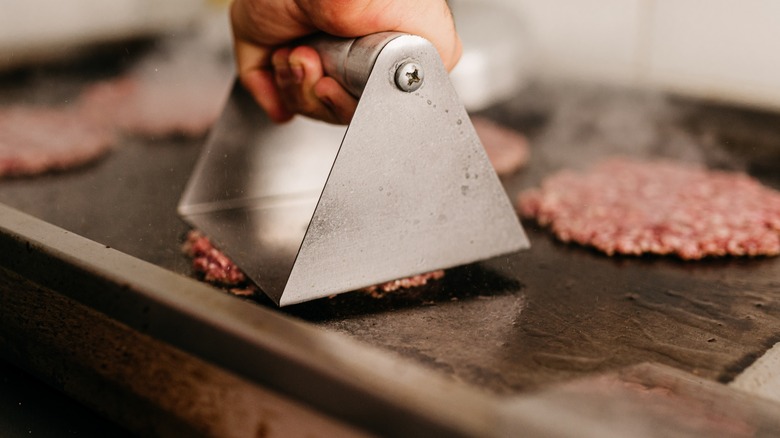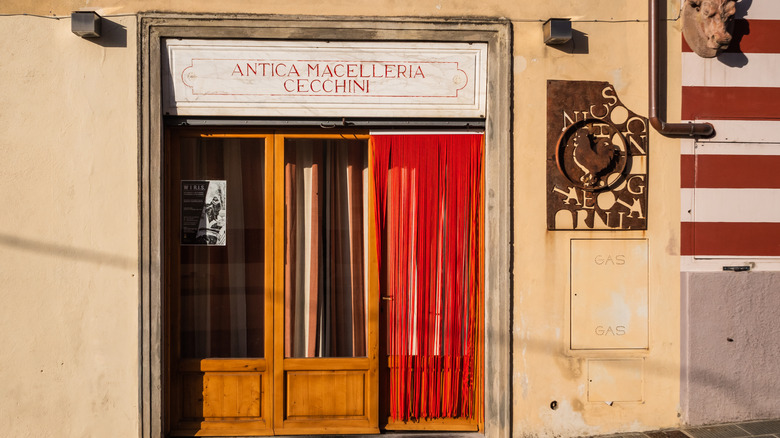From Burgers To Tartare, Famed Butcher Dario Cecchini Has A Beef Tip For You - Exclusive Interview
Artisan butcher and chef Dario Cecchini is a legend. As a native of Panzano, Italy, a small town in regional Tuscany, Cecchini maintains the tradition of an important line of work. Butchery, in his case, goes back through eight generations of family members and has greatly informed the work he does across his restaurants, shops, and food advocacy. Even with this ancestry in mind, Cecchini is profoundly focused on the future of his local food system and how it (should) connect to days past. In a recent exclusive interview with Tasting Table, Cecchini seemed surer than ever that simple foods are the key to better foods; foods that nourish our bodies and the earth at the same time.
Prior to his upcoming attendance at the South Beach Food & Wine Festival, Cecchini sat down to speak with us about many things, including the Taste of Italy dinner he'll be hosting at the festival and his tips for making an excellent tartare. The conversation was facilitated and translated by his wife, Kim Cecchini, who is every bit as passionate about the sentiments Dario shared. It has been lightly edited for length and clarity.
At South Beach Wine & Food Festival
I'd love to know what you have planned for your dinner at South Beach Wine and Food Festival.
So my idea is that as a butcher, and the experience of my ... family have been butchers for 250 years, and next year will be my 50th year butchering in my own shop.
We have always sought to have respect for and take responsibility for the animals. Seeking always to be responsible carnivores. And so I'll be bringing this perspective. I grew up eating meals my grandmother made. As this is foods that I grew up eating, a small family of butchers, in our own dinner table we were eating the cuts of meat that were the sustainable cuts. Basically, we were eating the leftover cuts.
I didn't eat my first steak until my 18th birthday, it was a birthday steak. So, the first cut that I'll be using will be the dish from the beef shank. It's a cut that's a little more hot, what people might be expecting. From the shank, I'm going make a beautiful brush and then a warm dish made with boiled beef. So after I have used the shank knees to create my boiled beef salad, I will then use the boiled beef that is leftover and create a dish that highlights that. It is a dish that is made from boiled beef and beautiful sweet vegetables. So it will be a night in three parts. Broth, I want beef salad, and my crunchy vegetables. And this will clearly be accompanied by Tuscan beef.
Do you have, especially around beef shank, any particular tips or tricks for how to prepare this cut well for home chefs?
To make the dish I'll be serving, it's super simple. You just have a big pot of water. You take carrots, celery and onions and cut them into chunks. The meat goes into the pot together with the vegetables for about three hours, and then you pull the meat out of its beautiful broth, and you add two pieces, and you leave what you find of the tendons, the cartilage, all of that good stuff. You leave it together with the beef, and you turn it into a warm beef salad, which is once again the onions, carrot, and celery, raw this time, julienned so that it looks pretty for you and it's a beautiful salad.
It's dressed really simply, just a little bit of good olive oil, salt, pepper, and a few drops of white wine vinegar. But that's it. I love serving simple, simple foods that are easy to understand and easy to recreate. I'm a butcher, my work is meat, and it's my job to communicate the simplest way that we can honor the beef, to honor the animal, and to show people that using every part well, from nose to tail, is not difficult because using every part well is my way of giving thanks to the animal for the sacrifice it made. Because I can see that what we are doing is we are killing in order to nourish our own lives. And so we have to give thanks by being careful with what we have.
On improving your own butchery skills
You mentioned fagioli. I would love to know what other type of Tuscan ingredients are some of your favorite to work with and to pair with a fine piece of meat.
We generally try to accompany our beef dinners with beans and also with a dish we call pinzimonio. It's like a crudite, fresh raw vegetables to dip in good olive oil. That's my culture.
For somebody who is looking to find their own butcher to work with, what are some signs that an artisan butcher is respecting the process? What are the things that they could look for?
Look for a butcher who is passionate about what they do. Look your butcher in their eyes, they say that the eyes are the mirror of the heart. So look for a butcher who is passionate and one who really tries to encourage their clients to try every part and use every part in the best way possible. If they only have filets and people's steaks in their counter, then they're just business. At that point, industry has stepped in and you're not talking to an artesian butcher.
Fantastic advice. What tips could you provide to a home cook who is looking to improve their butchery skills just within their house and their own cooking?
One thing could be that they shouldn't have their knives too sharp. As a butcher who cut himself many, many, many times, I don't want people to go out and buy necessarily super sharp. And I would suggest that they also respect the meats they're working with by doing the simplest recipes possible. And that they try to stay within the tradition of, for example, starting off with dishes that they imagine their grandmother might have or that they know that their grandmother might have cooked. As a wise person once said, "don't make anything that your grandmother would not have understood."
My Papa says "don't eat anything your grandmother wouldn't recognize," but just don't cook any recipes that your grandmother wouldn't recognize.
As we speak about knives, in addition to not purchasing knives that are too sharp, do you have any recommended tips for keeping your knives in good condition for butchery?
Probably the simplest way to have a wet stone at home and pass them on a wet stone regularly. But I believe that a very simple set of knives is more than sufficient. You may have to have some patience in sharpening them, but there really is no need to spend ridiculous amounts of money.
Tuscan essentials for the kitchen
What are some important pantry staples that home cooks should keep in supply regularly, for you?
Definitely beans. Nice cannellini, great northern white beans. Meat, some simple cuts of meat, not particularly expensive. A nice steak, potatoes, carrots, celery, onion. If you're lucky enough to have a balcony or a garden or even just a pot, maybe grow some sage and some rosemary. And certainly, as we're talking about what a good Tuscan would always have in their pantry, that would definitely start with beautiful olive oil, garlic, and definitely a good bottle of red wine
Do you have a specific wine that you like to drink when you're cooking bistecca? And if not, what is one of your favorite Tuscan wine pairings for this meal?
Yeah, a beautiful Chianti classical certainly would be appropriate as we sit here in the heart of the Chianti classico region. The blood of our earth.
Is there a particular vineyard or producer that you prefer yourself?
So our little village of Ansano, whose full name is Ansano in Chianti, is a village of less than 1,000 people. And in our village there are 37 wine producers. So we are always surrounded by beautiful wines, and all 37 are really good. You can't ask [me] to choose [my] favorite child. My favorite red wine are the 37 wines by the 37 producers. Any wine by the 37 producers are fine. Some are really quite well-known and some are so tiny they're basically invisible, but they're all really good.
How to find meat for a bistecca allá Fiorentina
What do you look for when sourcing meat for bistecca alla Fiorentina, and why do you recommend cooking the Florentine steak without salt or oil?
The bistecca alla Fiorentina is certainly a symbol of our tradition. It's a dish that is perfect for a party. It's a dish that's meant to be shared, so I would look for a cut that is well-aged, quite marbled, and then we really go right back to what I said about finding a good butcher.
When you're going to grill it, you want to be sure that it is not cooled out of the fridge, so that it has perhaps set out, wrapped up on the counter for four or five hours to come to complete room temperature. Nice hardwood charcoal fire. Certainly a good glass of red wine for the grill master because this person is carrying on a very important tradition, but I do insist that the meat should go on the grill without salt, without oil, because the food of the tribe is primitive food. It's enough to just have meat and fire, nothing else necessary.
I would always suggest that, and I do suggest, that my guests and any guests I would have at a table after putting down a beautiful steak in front of them is that they taste it first. Their first bite should be naked and no condiment, and perhaps they'll find that the meat is just as flavorable that way. We have also on our tables a beautiful extra virgin olive oil and our preferred topping, which is salt, so a salt and an olive oil can be on the table but that first bite should definitely be taken without either of them.
The smash burger might not work for Dario Cecchini
Your burger blend includes bone marrow, and I'm curious how the marrow enhances this burger blend, what other cuts you may include within it, and why you choose these?
For me, beef marrow is the most noble fat. So for me, it makes the mix more delicate and more harmonic, so that's my reason. It's an added value that is very important. It also circles back to my philosophy of using every part well.
Do you have tips for cooking hamburgers in particular, or thoughts on the smash burger trend in the United States? It's become quite big.
It sounds delicious, as long as it's not burnt.
What they aim for is very crusty, so-
For me, I'm not sure that would work because what I'm usually looking for in my burgers is to be quite rare inside.
What would be your suggestions for making tartare?
Of course you have fresh meat. You want really fresh meat. It's a more delicate situation when you're eating meat raw. You want it to be hygienic. What you would want to look for is a nice lean piece of meat that absolutely should not be filet. What you really want is a lean cut that can even be quite tough.
Because a lean, tough cut is going to be one of the muscles that work hard on the animal, like cuts from the legs, carrying the animals, they're going to be full of flavor. So what I do, he says, is I take those cuts and I mix them with beautiful olive oil. Those lean top cuts are the ones that have the most flavor, so you can chop it with a knife, so you want that lean cut that doesn't have too many nerves running through it.
You chop it with a knife, some sea salt, a little bit of cracked black pepper, some sweet paprika, minced garlic, chopped parsley, a little bit of fresh lemon juice, a lot more than you would ever imagine of olive oil, and then you massage it all together with your hands. Let it sit for five minutes and then eat it.
I'm hungry thinking about it.
Simple ingredients, not expensive. We need to make food for people. We don't have to just make fancy, expensive food. In this moment, I feel we really need to work hard to make better food for the people. Better quality, less bad fats, simple prices. Because for me, simple is better.
The future looks bright for Cecchini
Are there any upcoming projects or collaborations that you can tell us about or that you may be looking forward to in the near future?
One that comes to mind is we are working towards finishing a small restaurant here in Tuscany that is going to be a little more on the fast food side. I really want to create a place with quality food and good prices. It'll be based on traditional dishes from the Tuscan cuisine. It'll be healthy, it'll be good, it'll be sustainable, it'll be easy, just tray service because really my basic philosophy is good food, good price.
Is there a name for this restaurant so far?
Cecchini. Also, not only my name, but the name of my family for eight generations. This history is my family, not only one Cecchini, my eight Cechcini, grand grandfather, grandfather, my father, also my mother, my grandmother. Cecchini.
South Beach Wine & Food Festival runs from February 22 to the 25th. You can get tickets here.

